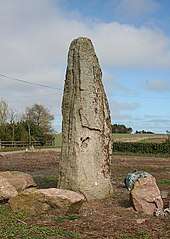Stone of Morphie
The Stone of Morphie is a standing stone about 700 metres west of the Coast Highway (A92 road) bridge of the River North Esk[1] and 400 metres east of the historic Mill of Morphie in Aberdeenshire, Scotland. Alternatively and historically, the monument is sometimes known as the Stone of Morphy. The stone is approximately 3.5 metres high and is unshaped and uninscripted; the base of this stone measures approximately 70 by 100 centimetres.[2]

The RCAHMS record number for the Stone of Morphie is NO76SW 6 7169 6273. According to RCAHMS,[3] the stone is "Traditionally said to mark the grave of a son of Camus, killed in a battle between the Scots and the Danes". Local tradition claims the site as an alternative burial site for a leader of a Viking army that was decimated by the Scots army at the apocryphal Battle of Barry in 1010 AD.[4] The date and mention of this battle rests with Boece.[5]
Etymology
The name Morphie may be of Brittonic origin,[6] and derived from an element consanguineous to Welsh morfa, meaning "a sea-plain".[6]
See also
References
- United Kingdom Ordnance Survey Map Landranger 45, Stonehaven and Banchory, 1:50,000 scale, 2004
- C.Michael Hogan, Stone of Morphie, 2007, The Megalithic Portal, ed. A. Burnham)
- RCAHMS official record NO76SW 6 7169 6273: Stone of Morphie, 1967
- Keith, A. (1842). "Parish of St Cyrus or Ecclesgreig". New Statistical Account of Scotland.
- George Hay. 1876. History of Arbroath, to the Present Time, with Notices of the Civil and Ecclesiastical Affairs of the Neighbouring District: with notices of the civil and ecclesiastical affairs of the neighbouring district, Published by T. Buncle, 448 pages
- Watson, W.J.; Taylor, Simon (1926). The Celtic Place-Names of Scotland (2011 ed.). Birlinn. p. 378. ISBN 9781906566357.
| Wikimedia Commons has media related to Stone of Morphie. |